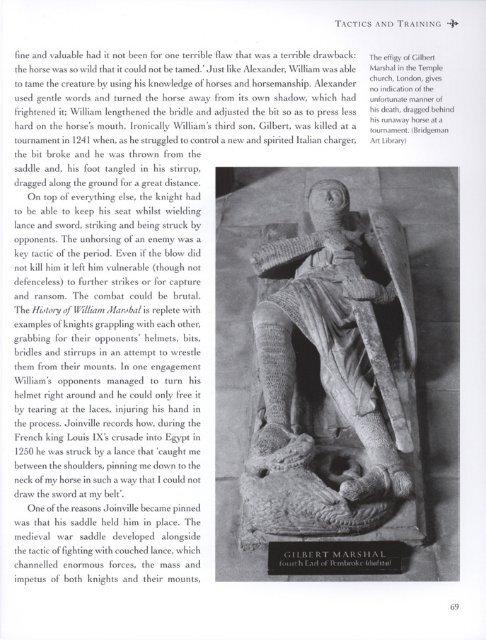Osprey - General Military - Knight - The Warrior and ... - Brego-weard
Osprey - General Military - Knight - The Warrior and ... - Brego-weard
Osprey - General Military - Knight - The Warrior and ... - Brego-weard
Create successful ePaper yourself
Turn your PDF publications into a flip-book with our unique Google optimized e-Paper software.
TACTICS AND TRAINING -}=>•<br />
fine <strong>and</strong> valuable had it not been for one terrible flaw that was a terrible drawback: effjgy 0f Gilbert<br />
the horse was so wild that it could not be tamed.' Just like Alex<strong>and</strong>er, William was able Marshal in the Temple<br />
to tame the creature bv using his knowledge of horses <strong>and</strong> horsemanship. Alex<strong>and</strong>er C UrC..' ° n ° n' k' ves<br />
J D D r no indication ot the<br />
used gentle words <strong>and</strong> turned the horse away from its own shadow, which had unfortunate manner of<br />
frightened it; William lengthened the bridle <strong>and</strong> adjusted the bit so as to press less his death, dragged behind<br />
hard on the horse's mouth. Ironically William's third son, Gilbert, was killed at a . „ 1 ,a . , „<br />
J tournament. (Bridgeman<br />
tournament in 1241 when, as he struggled to control a new <strong>and</strong> sprrrted Italian charger, Art Library)<br />
the bit broke <strong>and</strong> he was thrown from the<br />
saddle <strong>and</strong>, his foot tangled in his stirrup,<br />
dragged along the ground for a great distance.<br />
On top of everything else, the knight had<br />
to be able to keep his seat whilst wielding<br />
lance <strong>and</strong> sword, striking <strong>and</strong> being struck by<br />
opponents. <strong>The</strong> unhorsing of an enemy was a<br />
key tactic of the period. Even if the blow did<br />
not kill him it left him vulnerable (though not<br />
defenceless) to further strikes or for capture<br />
<strong>and</strong> ransom. <strong>The</strong> combat could be brutal.<br />
<strong>The</strong> Huftory of William Marshal is replete with<br />
examples of knights grappling with each other,<br />
grabbing for their opponents' helmets, bits,<br />
bridles <strong>and</strong> stirrups in an attempt to wrestle<br />
them from their mounts. In one engagement<br />
William's opponents managed to turn his<br />
helmet right around <strong>and</strong> he could only free it<br />
by tearing at the laces, injuring his h<strong>and</strong> in<br />
the process. Joinville records how, during the<br />
French king Louis IX's crusade into Egypt in<br />
1250 he was struck by a lance that 'caught me<br />
between the shoulders, pinning me down to the<br />
neck of my horse in such a way that I could not<br />
draw the sword at my belt'.<br />
One of the reasons Joinville became pinned<br />
was that his saddle held him in place. <strong>The</strong><br />
medieval war saddle developed alongside<br />
the tactic of fighting with couched lance, which<br />
channelled enormous forces, the mass <strong>and</strong><br />
impetus of both knights <strong>and</strong> their mounts,<br />
69







